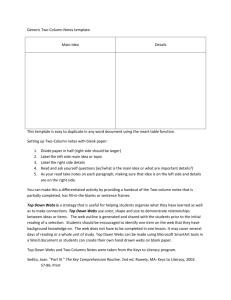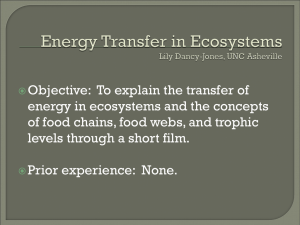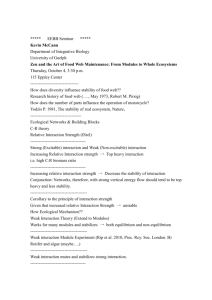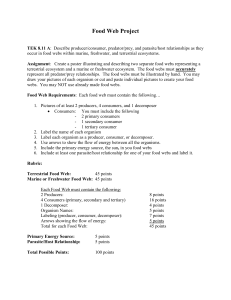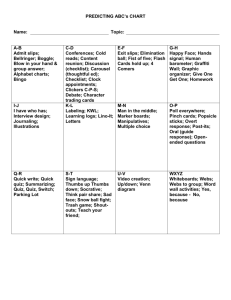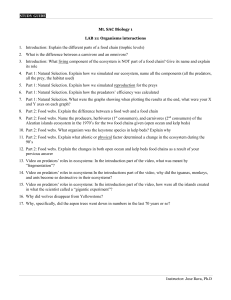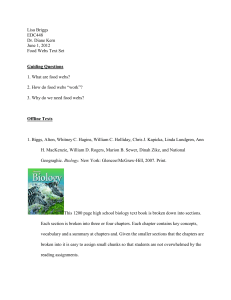WeBS Steering Group 34
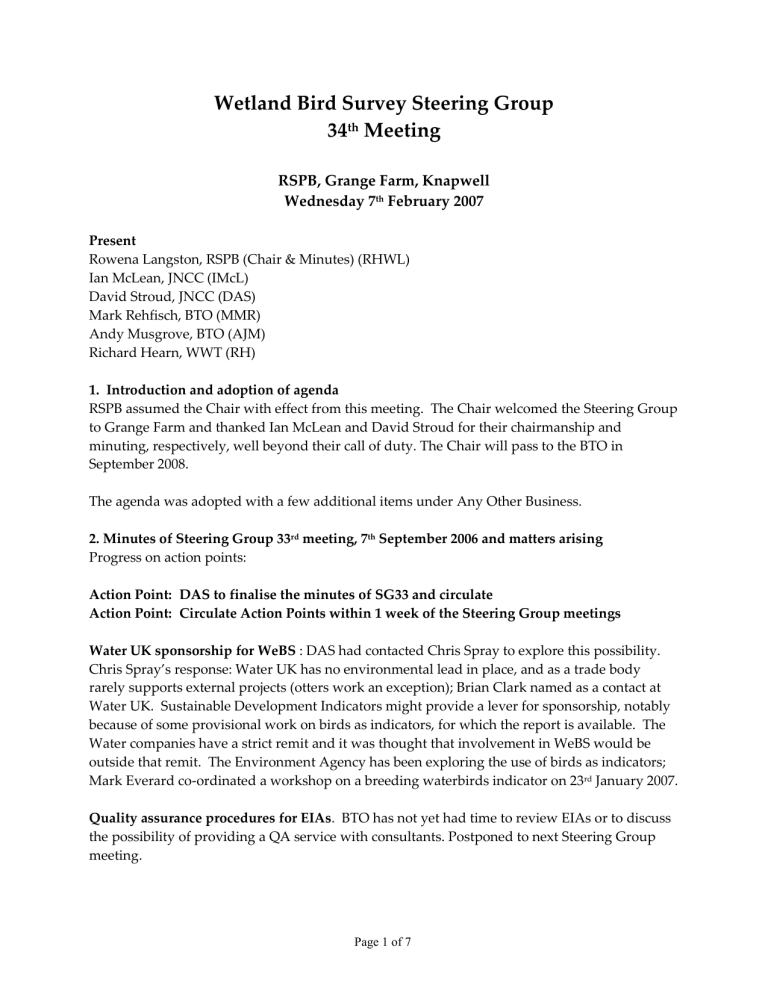
Wetland Bird Survey Steering Group
34
th
Meeting
RSPB, Grange Farm, Knapwell
Wednesday 7
th
February 2007
Present
Rowena Langston, RSPB (Chair & Minutes) (RHWL)
Ian McLean, JNCC (IMcL)
David Stroud, JNCC (DAS)
Mark Rehfisch, BTO (MMR)
Andy Musgrove, BTO (AJM)
Richard Hearn, WWT (RH)
1. Introduction and adoption of agenda
RSPB assumed the Chair with effect from this meeting. The Chair welcomed the Steering Group to Grange Farm and thanked Ian McLean and David Stroud for their chairmanship and minuting, respectively, well beyond their call of duty. The Chair will pass to the BTO in
September 2008.
The agenda was adopted with a few additional items under Any Other Business.
2. Minutes of Steering Group 33 rd meeting, 7 th September 2006 and matters arising
Progress on action points:
Action Point: DAS to finalise the minutes of SG33 and circulate
Action Point: Circulate Action Points within 1 week of the Steering Group meetings
Water UK sponsorship for WeBS : DAS had contacted Chris Spray to explore this possibility.
Chris Spray’s response: Water UK has no environmental lead in place, and as a trade body rarely supports external projects (otters work an exception); Brian Clark named as a contact at
Water UK. Sustainable Development Indicators might provide a lever for sponsorship, notably because of some provisional work on birds as indicators, for which the report is available. The
Water companies have a strict remit and it was thought that involvement in WeBS would be outside that remit. The Environment Agency has been exploring the use of birds as indicators;
Mark Everard co-ordinated a workshop on a breeding waterbirds indicator on 23 rd January 2007.
Quality assurance procedures for EIAs. BTO has not yet had time to review EIAs or to discuss the possibility of providing a QA service with consultants. Postponed to next Steering Group meeting.
Page 1 of 7
Action Point: BTO to a) review a sample of EIAs utilising WeBS data and b) informally discuss with consultants the possibility of a data QA service. For discussion at SG35 in
September 2007.
Publication of WeBS Steering Group minutes online. Agreed to publish full minutes, with effect from SG34, subject to BTO Management agreement. No need for JNCC to summarise the minutes for SG33.
Action Point: BTO to seek Management approval for publication of the WeBS SG minutes.
Action Point: Minutes of WeBS SG meetings to be posted on the web once agreed by the
WeBS partners, with effect from SG34.
Aerial survey data were included in Waterbirds in the UK 2004/05, in a separate table. There was a brief discussion about whether data included were counts or the analysed data from
Distance, including interpolation – both were thought useful to present. Aerial survey data are not analysed routinely for EIAs, which would be a worthwhile exercise.
NEWSII: fieldwork is close to finishing, having been extended to mid-February. There has been some professional input (2 staff); 100 days of field time were funded by SNH. Good coverage was achieved in the Orkneys, Mull, NW coast, Coll & Tiree. Extended cover in the Western Isles
(20-25%) has been possible compared with poor coverage in previous surveys. Coverage will be reviewed once data have been collated.
European NEWS I has not yet been completed and has suffered considerable slippage. The papers for individual countries are finished, together with an introduction. The overview chapters have yet to be completed. It is hoped to complete by the end of April 2007.
Scottish waterbird indicators. The report has not been finalised; comments are awaited from the Scottish Executive. This is a conservation indicator in which species comprising a high proportion of the population in Scotland, contribute more to the indicator.
3. Work Programme for 2007/08
WeBS/34/5 Months to use for WeBS indexing
Any change requires justification but the published paper is based on waders, rather than wider waterbirds. It was agreed to re-run the indices for all species if time allowed or otherwise a suitable subset, using both methods and then decide which approach to apply.
Action Point: BTO to re-run indices using both methods for all or a subset of species, identify differences and recommend best approach, by end April 2007.
WeBS/34/6 Gulls
Page 2 of 7
The best way to monitor gull populations is roost counts, but there are practical difficulties.
Currently, sites comprising a single sector, notably inland sites, are more likely to be counted regularly as part of WeBS, whereas coastal sites often have too many gulls to enable satisfactory counts to be made without compromising counts of the priority waders and wildfowl. The best way forward is likely to focus on decennial roost surveys (WINGS) plus encouraging annual monitoring of a stratified sample of roosts via WeBS. Some data are already collected by supplementary gull roost counts as part of WeBS. BTO to compare trends from core WeBS data and roost counts for regularly counted sites, and make recommendations for WeBS. The partners agreed to encourage more routine counting of gulls where possible, seeking at least orders of magnitude where counts are not undertaken. WeBS Online was seen as a useful tool for this purpose. Recommendations to be discussed with the WeBSLOAC to develop the most suitable approach to improving gull monitoring within WeBS.
Action Point: BTO to bring forward recommendations for discussion with WeBSLOAC
WeBS/34/7 Counter network
General enthusiasm among Local Organisers for the WeBSLOAC, and just one remaining member to be recruited before arranging the first meeting, probably around April 2007. WeBS partners invited to attend.
Action Point: BTO to circulate papers and meeting arrangements to WeBS partners.
WeBS/34/8 Health & Safety
Note on general health and safety information for volunteer fieldworkers circulated to partners.
WeBS/34/10 WeBS Online
The Chair thanked the BTO, on behalf of the WeBS partners, for all their work in bringing this to fruition. WeBS Online is seen as a significant development for WeBS, to provide more direct contact with counters and improve efficiency. WeBS Online is up and running, now with 50 - 60 registered users, with whom contact is made easier via email. Staff from the WeBS partners are already being registered to use the system. This raises the need for annual review of eligible users to ensure that access rights are appropriate. Further development of WeBS Online was acknowledged to be a high priority for the scheme.
Action Point: BTO to complete roll-out of WeBS Online and to continue developing the system.
Action Point: All partners to promote WeBS Online among colleagues.
WeBS/34/11 Core Count Stratification
Defra indicators work (due September 2007) has made it necessary to develop stratification ahead of schedule. Characterisation of waterbodies is the key time-consuming aspect of this task and Graham Austin is working almost full time on this task. Once the dataset of waterbody types is complete, work will begin to identify types and areas poorly represented within WeBS.
Page 3 of 7
Target areas for coverage by new counters will prioritise designated sites, then sites which contribute to improving the ability of WeBS to generate population estimates and indices. It was suggested that a workshop on stratified sampling, to bring together the WWT studentships and the BTO could be useful, provisionally in June/July 2007 so that outputs could feed into the
WeBS stratification work.
AP RH to speak to WWT PhD students about the desirability of a workshop in June/July.
WeBS/34/13 Alerts
Originally, it was envisaged that alerts would be produced for 1/3 of SPAs and 1/6 SSSIs each year. In reality, it is more efficient to run the alerts for all SPAs or all SSSIs at once, although the preparation of the site and species texts is time consuming. It was agreed that the alerts are needed on a 3 year cycle for SPAs and 6 year cycle for SSSIs, not more frequently as this can lead to information overload, and that the BTO would determine how best to deliver this. RHWL also suggested that integrating the 3-yearly revision of population estimates would aid work flow. The IAOWG need to be updated on the alerts process and to agree future roll-out. Better targeting of information to partner staff is being achieved by identifying staff responsible for given sites. The BTO’s proposal for the new-style site texts was agreed overall, with the suggestion that these should refer to all relevant species and species names should be bold.
Action Point: BTO to advise how best to split the work to meet the SSSI 6 yr reporting cycle and SPA 3yr reporting cycle, possibly integrating population estimates revision in one of the three years
Action Point: BTO to bring paper forward to IAOWG by end February 2007, for meeting on
13 March.
WeBS/34/16 WeBS Data Requests
Surplus £24,906 carried forward from 2006/07, considered under Finances. WeBS Online is expected to lead in time to reduced revenue from data requests as routine data requests will be more automated, but initially, consultants will not have access so data requests will continue as at present.
WeBS/34/19 Winter Gull Roost Survey
The new 1% thresholds for gulls will be applied in WeBS once the roost survey paper has been accepted for publication. The paper is close to finalisation.
WeBS/34/25 Recent Publications
Action Point: BTO to put list of publications on WeBS pages of website
Action Point: BTO to circulate drafts for comment to WeBS partners of papers that use WeBS data and where appropriate WeBS partners should be co-authors, as per the WeBS Agreement
4. Finances
Page 4 of 7
On behalf of the WeBS partners, the Chair thanked AJM for presenting clear and comprehensive budgets for the meeting and for the evolving efficiencies in running WeBS. AJM presented the financial breakdown and revised budget for running WeBS for 2007/08 to 2009/10 inclusive.
Cost savings of WeBS Online in terms of data capture and processing, partner data requests etc will be seen progressively, albeit there has been considerable investment in setting up WeBS
Online. The options available to the WeBS partners are to reallocate the savings to other work within WeBS or reduce the total cost of the scheme.
WWT confirmed its contribution of £50,000 for 2007/08. IMcL stressed that it would be helpful if
WWT could bring forward a longer-term agreement than year on year. WWT was reminded of its reduced contribution compared with the other partners.
IMcL outlined the situation with regard to the JNCC budget, informing the partners that they are working to tight budgetary constraints, particularly affecting the surveillance programme, partly due to inflationary increases. Nonetheless, JNCC’s preferred way forward would be to re-invest savings from WeBS to increase take-up of online data submission and to enhance delivery from the scheme. IMcL acknowledged that pressures on 2007/08 budgets and on the corporate plan for next 3 years gave rise to budgetary uncertainty.
RHWL presented the situation for the RSPB’s research and monitoring budget, which is also under pressure. The prospect of a possible reduction in the RSPB contribution had been indicated at SG33, and it had proved necessary to reduce its contribution to WeBS to £65000 in
2007/08. RSPB and BTO now need to agree a new contract for the three years 2007/08 to 2009/10.
If it is assumed that 3 partners each contribute £65,000 to the scheme’s £255,504 costs in 2007/08 and the £24,906 surplus from data requests is used to offset the £50,000 contribution from WWT, there remains a surplus of £14,402.
Potential areas for increased input to improve WeBS in the longer term:
Further development of WeBS Online
Training via WeBSLOAC
Coverage of remote areas
Aerial survey
Pilot work towards stratification
There is a need to review the partnership as a whole, notably in terms of the funding formula, and the effectiveness of forward planning of the scheme set against differences in partner contributions and the terms/duration of agreements with the BTO.
Action Point: All to raise with their respective managers of WeBS partners the funding formula and terms/duration of future agreements with BTO (ideally minimum of 3 years).
Page 5 of 7
Action Point: WWT to investigate the possibility of a longer term WeBS funding agreement.
Action Point: Enhanced roll-out of WeBS Online with any surplus in 07/08, including talks and visits to local counters.
5. Research update
RH had been unable to obtain an update for the two WWT PhD studentships in time for this meeting. Teresa Frost is based at Canterbury, working on statistical analyses of WeBS data with
Byron Morgan’s group, whilst Marco Girardello is based at Newcastle, studying the physical characteristics that determine waterbird distribution on inland waterbodies.
Action Point: RH to circulate update as soon as available, in approximately two weeks.
Action Point: BTO to invite both students to give research seminars and to notify other partners of dates for these.
6. OS licence update
JNCC confirmed that they will not fund future licences. Google Earth is increasingly in use for various WeBS tasks. Current use of OS maps for WeBS is licensed under the Defra AIV contract.
RHWL raised the RSPB offer to include WeBS uses under its OS licence if needed in future.
7. Waterbirds In The UK
BTO is chasing late data for the 05/06 report, loading data received to date, and hoping to circulate the 05/06 report in October 2007.
The pdf version of the 04/05 report will be/is now available online.
8. Matters arising
None
9. Any Other Business
Access difficulties in Poole Harbour – a local landowner had made access subject to annual payment of a £100 donation to his church; a rather unreasonable request for a voluntary scheme.
Fortunately for WeBS, such access difficulties are very rare.
Suppression of cormorant counts in Greater Manchester gave cause for concern. Currently, the
LO is trying to resolve the issue, but BTO may need to write formally to stress the need for data to underpin objective decision-making.
Wetlands International database. Alterra aim to complete by December 2007 rather than
December 2006 as originally forecast, although there may be problems with funding. This work is very welcome and will deliver the long-awaited functional database which had been previously beset by problems.
Page 6 of 7
MMR had met recently with BASC, Tim Russell (Director of Conservation) and John Harradine
(Director of Research). BASC expressed concerns that the alerts give the impression that wildfowling is a major contributory factor in the declines observed on some sites. If there is research demonstrating this to be the case that is one thing, but in its absence, BASC is already encountering attempts to stop wildfowling on some sites on the basis that it may be a problem.
MMR also met with The Wildlife Trusts. BASC and the Wildlife Trust are agreeable to placing articles from WeBS, in their respective magazines, that can be used to recruit new WeBS counters. This was agreed to be a useful way of reaching different audiences and other potential outlets would be investigated.
MMR also mentioned that the BOU is planning a conference on introduced/alien species in
November 2008 and is seeking recruits for the organising committee.
Waterbirds Around the World, the proceedings of the Global Flyway conference in Edinburgh in
2004 will be launched on 12 March 2007.
10. Dates of next meetings
5 September 2007 JNCC
6 February 2008 Grange Farm
5 September 2008 Grange Farm (Chair moves to BTO)
Page 7 of 7
